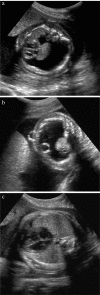Lysosomal storage disorder in non-immunological hydrops fetalis (NIHF): more common than assumed? Report of four cases with transient NIHF and a review of the literature
- PMID: 23137060
- PMCID: PMC3552949
- DOI: 10.1186/1750-1172-7-86
Lysosomal storage disorder in non-immunological hydrops fetalis (NIHF): more common than assumed? Report of four cases with transient NIHF and a review of the literature
Abstract
Background: Lysosomal storage disorders (LSD) are a rare cause of non immunological hydrops fetalis (NIHF) and congenital ascites. The reported incidence is about 1%. The incidence of idiopathic NIHF is estimated to be about 18%.
Patients and methods: We report four cases with transient hydrops fetalis resulting from LSD and performed a literature review on LSD with NIHF and congenital ascites in combination.
Results: At present, 12 different LSDs are described to be associated with NIHF or congenital ascites. Most patients had a family history of NIHF, where the preceding sibling had not been examined. A diagnostic approach to the fetus with NIHF due to suspected LSD either in utero or postnatal is suggested. Transient forms of NIHF and/or ascites in association with MPS IVA, MPS VII and NPC are described for the first time in this publication.
Conclusions: LSD should be considered in transient hydrops. Enzymatic studies in chorionic villous sample or amniotic cultured cells, once the most common conditions associated with fetal ascites or hydrops have been ruled out, are important. This paper emphasizes the fact that LSD is significantly higher than the estimated 1% in previous studies, which is important for genetic counseling as there is a high risk of recurrence and the availability of enzyme replacement therapy for an increasing number of LSD.
Figures
References
-
- Castillo RA, Devoe LD, Hadi HA, Martin S, Geist D. Nonimmune hydrops fetalis: clinical experience and factors related to a poor outcome. Am J Obstet Gynecol. 1986;155:812–816. - PubMed
Publication types
MeSH terms
LinkOut - more resources
Full Text Sources
Medical


